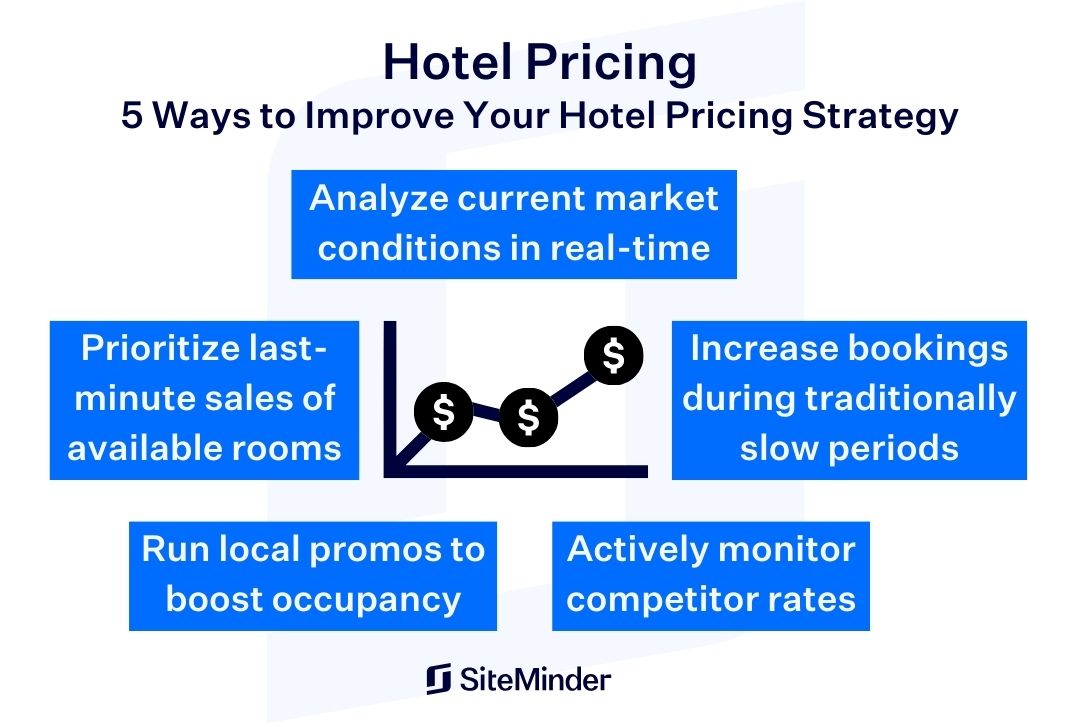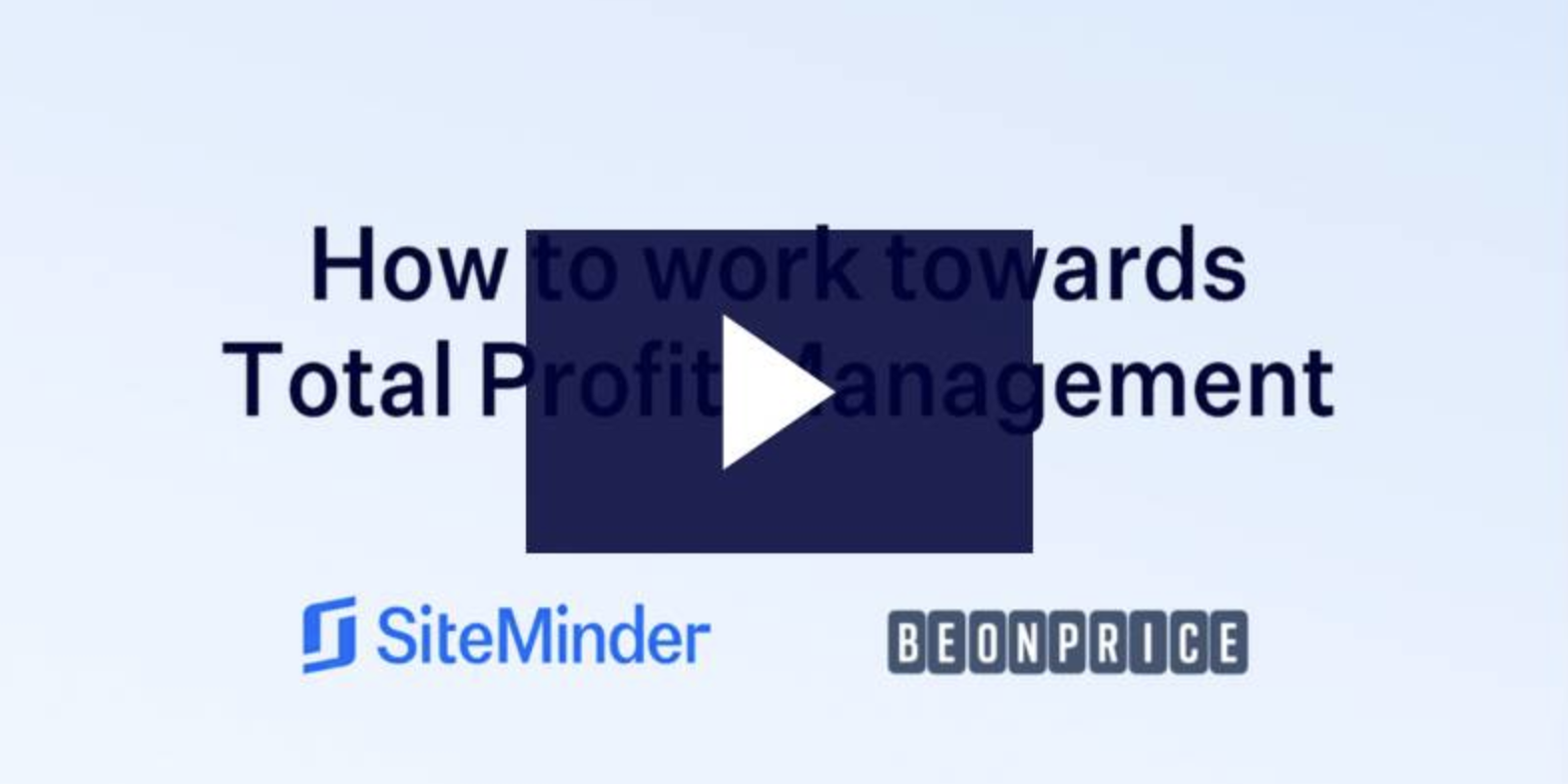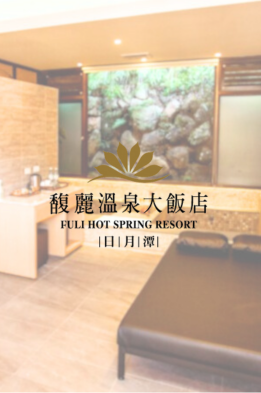What is hotel pricing?
Hotel pricing is the method by which you optimise your property’s rates to maximise both occupancy and revenue. Providing guests with value for money while trying to maintain a stable bottom line and avoid being undercut by competitors is a complex task that needs constant attention if your business is to succeed.
Hoteliers need to stay proactive when it comes to pricing their rooms. Capturing real-time data and following current market trends, along with your own business trends, is vital for maintaining an optimal pricing model for your hotel. Adjusting your rates and managing the revenue you win from bookings cannot be viewed as a set and forget practice.
This blog will help explain everything you need to know about hotel pricing and give you helpful information on strategies to use at your property.
*Looking for SiteMinder’s pricing page instead? Click here to view your options
Table of contents
How does hotel pricing work?
Hotel pricing is determined by the basic principle of supply and demand. During peak seasons or events, when demand is high, prices tend to rise. Conversely, during off-peak times, prices might be lowered to attract more guests.
However, it’s not just about seasonal fluctuations. Hotels must also consider factors like:
- Competitor pricing
- Guest reviews
- Operational costs
- Desired/required profit margins
Hotel pricing is a delicate balance of strategy, market research, and guest expectations, all aimed at achieving optimal occupancy and revenue. With the advent of new automation and technology, many hotels now employ revenue management software (such as SiteMinder) that use algorithms to adjust room rates in real-time, maximising revenue potential.
Get your pricing right and win more revenue Optimise your hotel's pricing strategy while also reducing your workload with SiteMinder's dynamic revenue tools.
Understanding room pricing at your hotel
Revenue management and room pricing can become very complex, very quickly. When you aren’t a professional revenue manager it can seem overwhelming. The temptation to look no further than the simple room pricing you’re already employing may be hard to resist. The skills required tend to transcend many areas including technology, customer service, finance, and more so it can be very hard to feel like you’re covering all the bases and staying on top of your pricing.
Prices can change not just every day but sometimes every hour depending on demand. This is the kind of agility revenue managers are faced with achieving.
Pricing your hotel rooms is about getting the most revenue possible out of each individual room. Don’t think about what the room is worth; think about how much value you can get out of it – the guest will often be prepared to pay more money than the flat-rate if they sense an opportunity to get a little extra benefit.
Occupancy also plays a role in the way you price your rooms. After all, an unsold room achieves nothing so pricing your rooms to maximise occupancy can often be a better tactic than pricing rooms to maximise profit on them individually. In a highly competitive location, it’s sometimes necessary to lure guests in with lower rates. At least then you have the guests and your competitors don’t.
You can then find ways to gain more revenue from the guests through other services offered at the hotel.
Every hotel has its own unique room pricing considerations depending on:
- Location
- Size
- Market demographics
- Level of competition
- Type of service offered
Unfortunately there’s no one-size-fits-all, so the advice offered in this blog should be adapted as you see fit to your specific business.
Hotel pricing compliance to follow
As with all things in the hotel business, there are many compliance expectations to follow, depending on local legislation, as well as the rules imposed by having listings on different booking channels.
It’s impossible to have a prescriptive list of “Things You Must Do”, but there are some consistent regulations that also work as best practice. This includes:
- Clear and accurate pricing (e.g. guests pay what they expect to pay)
- Adhering to all claims made in advertising (e.g. guests get what they paid for)
- Breakdown of any additional charges (e.g. local taxes or service fees)
Rate parity deserves a special mention as well, as this is a requirement for many OTAs and is generally considered a norm for the industry. No matter where a room is listed, guests should find that it is the same standard price.
Rate parity allows guests to trust that they are always getting the best deal possible, improving long-term guests loyalty and encouraging guests to book directly with you (i.e. they don’t go shopping around on OTAs thinking they can get a better deal).

Establishing a hotel pricing strategy
Crafting and executing your hotel pricing strategy requires you to do more than establish rates for your rooms during particular seasons. You’ll want to go beyond that – optimising your pricing strategy so that you maximise the revenue that you generate per room and per guest.
There are a number of questions that should surround your pricing strategies:
- What do your guests want?
- Which strategy will complement the business mix?
- How will different strategies affect connected channels and distribution partners?
- How does your strategy integrate with your channels?
- Who are the experts that can help determine the right strategy?
Let’s take the first question as an example. Certain guests will prefer or be accustomed to particular pricing methods. For instance, some may like a cost breakdown of their stay by day, while others are happy with a rate for their entire stay.
This is where either Daily Pricing or Length of Stay pricing strategies might come into play.
Sometimes you can spend far too long trying to understand the strategies of your competitors, asking:
- When are they increasing their rates?
- Why are they decreasing their rates?
- How often do they discount?
- Are my rates on par?
- Is my hotel offering value for money?
Competitors are certainly not the only factor that should influence your hotel’s room pricing. Often it’s better to look at competitors after you think you’ve priced your rooms to advantage and then adjust as needed.
With the increased availability of real-time marketing data, it’s entirely possible to design a multi-tiered dynamic pricing strategy that can change at a moment’s notice. With accurate prior knowledge you can easily:
- Optimise your room rates
- Understand how competitive your room pricing is
- Increase your chances of being booked online
- Use the market to your advantage, rather than be dictated by it
Technology can also play a major role in accurately and effectively establishing pricing strategies at your hotel. Pricing and business intelligence tools make it much easier for you to monitor the market, track competitors, collect data, forecast, and make quick adjustments.
There’s no pricing strategy that is perfect for any hotel. Each property must consider the pricing strategies that work best for its particular brand. A revenue manager will spend a lot of time analysing data and other influencing factors to ensure the business is operating with the best possible chance to maximise income.
Hotel pricing strategy examples
As discussed, each individual property will have a pricing strategy that works for them but there are common practices across the industry that can be applied to your business. The method you use to price your rooms can be extremely diverse depending on what you focus on.
Here’s a list of the most common pricing strategies your hotel might find useful:
1. Cost-based pricing
This involves adding up all the costs of running your hotel from admin, to cleaning, to food and beverage etc. Then, when you determine how much profit you want to make, add a markup to each room.
Fixed (costs that aren’t dependent on how many guests you have or how many rooms you sell) and variable (costs that do change in response to guest numbers) costs need to be taken into account so the list of expenses can get quite extensive but the approach is relatively simple.
So if the cost of running your hotel is equal to $10,000 every month, the profit you add on top will give you a total amount. You can divide this figure by the number of rooms you can rent and price accordingly.
This strategy is logical and simple but not very conscious of competition.
2. Customer-based pricing
Customers pay no heed to your underlying costs, they wouldn’t really have a clue about how much it’s costing you to open a room for them. They pay based on what they think the room is worth. So the perceived value of your room could be much higher than what it costs you – or lower.
Guests care about the value and benefits you can give. Their perception of value often comes from the connection they feel to your brand and social proof. Rave reviews that promise wonderful memories means the perceived value of your hotel will increase. So even though your rooms haven’t changed, you could raise your rates.
This strategy has the potential to deliver very high profits and is very flexible around demand, however it won’t always be effective if demand drops or customers do a lot of research and see much lower prices at a similar competitor.
3. Competitor-based pricing
It’s unlikely that you will be the only hotel on the market so it pays to see what others are doing. Completing an assessment of all your competitors can allow to make an accurate judgement on how to price your hotel.
There may be opportunities to increase bookings at your hotel by charging an acceptable rate for your business that is still lower than competitors, or you can increase profits by charging higher rates because your offer is superior.
This is a good strategy in areas of high competition but be careful to avoid pricing wars that just chip away at your profit margin.
It’s probably more common that using a combination of all these methods will provide you with the best results, rather than sticking with one.
4. Open pricing
Open pricing defines the flexibility hotels around the globe have to set their prices at different levels depending on the various target markets and distribution channels they deal with. This luxury of choice allows hotels to forecast more accurately.
For example, a high-end hotel may usually attract guests with no budget constraints but in the off-season bookings will drop and the hotel can drop rates to attract travellers who normally would not be able to afford the stay.
While the average daily rate of the hotel will be lower, occupancy will remain steady and revenue will continue to turnover.
5. Value-added pricing
You can set your room rates higher than the local competition while also offering more extras in the basic package. This gives the illusion that the hotel offers a premium experience that focuses on value rather than just low rates.
6. Transparency pricing
No matter your audience, hotel guests always want to feel they are getting a good deal, and with so many OTAs, price comparison sites, and other hotel price research tools available to the average consumer, ‘transparency’ has become a core consideration for any pricing strategy.
Here’s an example.
Research by SalesCycle revealed that many travellers abandon bookings upon seeing the total price, with 39% indicating they’re still researching. To address this, UK hotel chain Shire Inns introduced a price comparison feature on its site, allowing guests to compare its rates with major online travel agencies (OTAs).
While seemingly risky, this move acknowledges the modern traveller’s desire to shop around while simultaneously encouraging the potential guest to stay on Shire Inns’ own website and, once they discover they are getting a great deal, to book directly through them (rather than wherever else their Google search may eventually take them).
The result? Shire experienced a notable boost in conversion rates and were able to retain more of their revenue via direct bookings by giving their audience what they wanted: easily accessible, available and transparent pricing.
7. Discount pricing
Used in slow seasons to boost occupancy by dropping base rates. Revenue can be made up through other services in the hotel.
8. Price per segment
Offering the same product at different prices to different types of customers. E.g ‘family rate’
9. Length-of-stay pricing
When demand outweighs supply, it can help to implement a rule where guests are ‘obligated’ to stay a minimum number of days. In such cases, lower rates may not be necessary.
10. Daily pricing
Daily pricing or “dynamic pricing” is a strategy in which a hotel adjusts its rates on a day-to-day basis, changing based on factors like supply and demand (both forecasted and actual). This allows hotels to maximise their revenue and mitigate losses by ensuring they have the best possible deal available.
For larger hotels, it’s crucial to have this strategy backed up with enabling automated technology – manual daily pricing is doomed to failure when there are hundreds (or thousands) of price changes required to stay ahead of the game.
11. Positional pricing
Basing your rates off brand strength and reputation.
12. Penetration pricing
Positioning yourself as the cheapest in the market. Be mindful of how travellers will perceive your hotel – you need to retain the opportunity to sell at higher rates.
13. Skimming
Positioning your hotel among the most expensive. Price leaders often achieve among the highest profitability, however the consumers need to clearly understand the reasons that they would pay more for staying at your hotel.
Most hoteliers would agree one of the most pressing issues they face is trying to keep up with their peers and staying on top of their hotel pricing strategy in a hyper-competitive market. The travel industry is so dynamic, a matter of months can see you fall behind the latest trends.
The figures you glean from your competitors will help you manage your yield as you can increase your average daily rate (ADR) and revenue per available room (RevPAR) by comparing your live minimum/maximum rates against your competitors’, based on length of stay (LOS).
Optimise your pricing and maximise room revenue
SiteMinder connects with leading revenue management systems to automatically update your optimised rates across all distribution channels in real-time, maximizing the yield of every room through intelligent pricing.
Learn More
Hotel room pricing calculator
Adopting a cost-based pricing model will help you figure out how much each of your hotel rooms will, or should, cost.
It’s a simple formula but may not always be so easy to calculate. You need to add up all the costs of running your hotel and divide it by the number of rooms you have to sell. This will give you an average figure for each room, meaning you should charge at least that much to break even.
The reason it can be a complex process is that your hotel is likely to have a lot of expenses, some fixed and some variable. Collating this list may take some time.
Fixed costs
Fixed costs include things such as taxes, staff wages, utilities, and maintenance. They’re fixed because the amount of guests you have at your hotel shouldn’t impact them.
Variable costs
These include things like food, beverages, supplies, and amenities. They’re variable because the number of guests you have will probably impact them directly.
For example, if fixed costs equal $5,000 and variable costs are $50 per guest/room. With 40 rooms the average cost works out to be around $150. To profit, you either need to set your rates higher, reduce costs, or produce extra revenue from guests through other services.
Unconstrained demand in hotel pricing
Unconstrained demand refers to the maximum bookings you could get with unlimited rooms based on demand and not limited by the actual physical inventory. It’s your total demand for a particular date irrespective of your capacity.
You should identify when unconstrained demand is above the capacity of the hotel. This is an important part of your hotel revenue management strategy. It will help you calculate your Last Room Value for certain dates, and possible length of stay restrictions. Once peak periods are detected, you can start regretting low paying business.
Historical data capture will help to calculate potential unconstrained demand. It is possible to develop manual tools which would help to identify those periods, such as with excel.
When it comes to maximising your hotel’s revenue, supply and demand is a principle that should be cleverly implemented. Strategic control of your hotel’s inventory is the name of the game to engage revenue management disciplines.
Competitive hotel room pricing strategy
Hours – and in some cases days – can be lost trying to understand and stay ahead of a competitor’s room pricing strategy.
When do they increase rates? How often do they discount? Are your prices on par? Is your hotel offering value-for-money? So many questions. So few answers. And so little time.
How can you use revenue management strategies to get ahead in today’s increasingly competitive landscape? By keeping a close eye on the local competition.
Among other things, your hotel should be monitoring the room rates of your competitors so you can see just how competitive your pricing is and react in a timely manner when needed.
Here are a few examples of what you can do with the information at hand:
1. Value-match competitors
One of the ways you can use competitor pricing to increase your hotel’s revenue is by matching them on price.
Set one room rate at the same price point as competitors, and set another room at a slightly higher rate. This allows you to attract deal seekers without sacrificing the opportunity to make a slightly bigger profit.
Keep in mind that value-for-money is the key point here – value-matching goes beyond bringing your hotel in line with your competitors’ rates or simply making your hotel rooms cheaper.
2. Run effective promotions
Continuing with the idea of value-for-money, promotions are one of the best ways to keep up with, and stay ahead of your competition.
When you notice your competitors are doing it – probably in the lead up to an event in your local area – find out what their rates are, and then set your rates at the lowest price possible to draw a crowd. This is your opportunity to be proactive and truly get ahead of the pack.
Look at the details of the room offers. Do they include breakfast? How many nights is the special rate on offer? Are there any spa or restaurant incentives factored in? Think about how your hotel can give guests that little bit extra.
A word of caution, though: you should only do this in short promotional bursts so your hotel isn’t perceived as low-quality or constantly discounting.
3. Meet market demand
Monitor your competitors’ rates to look for signs in the market that indicate demand is increasing and inventory is getting booked out. Then you can react accordingly.
For example, when your competitors increase their rates or you notice their rooms are closed out, increase your own room rates to make sure you’re not losing out on revenue and profit.
4. Maximise midweek bookings
While discounted promotions are great, they rarely sell enough to offset reduced revenue. Instead, look at your competitors’ rates and add value to increase midweek bookings.
Create and promote special packages which offer additional services. Think clearly about who your weekday audiences are. We recently wrote about attracting midweek guests, with some great tips for boosting revenue during quieter times. Did you know that for a two-night stay it’s likely your guests will travel about four hours’ drive from your hotel’s location?
Another great approach is collaborating with tourist attractions locally and submit advertisements or editorial to newspapers and websites in population centres within the vicinity promoting midweek breaks that include bus tours, wine tasting trips, or a concert.
5. Sell stressed last-minute inventory
Data from Hotels.com shows that 50% of travellers who book via mobile devices do so for last-minute or next-day stays. This trend represents a huge opportunity for hotels to sell their very final rooms, right up to the last minute. By monitoring your competitors’ rates in real-time, you’ll be able to make the right pricing decisions to ensure those final rooms are sold without compromise.
The best way to do this is through a pooled inventory system via a channel manager. A seamless two-way connection to your hotel’s various booking sites is key to ensuring the constant flow of information is reliable.
Bonus tip:
Understand the importance of real-time data
Without real-time data, you won’t notice competitor rate changes – or by the time you do, it will be too late to respond in a way that maximises your own hotel’s revenue.
Having real-time data allows you to assess the level of live demand in the market so that you can react faster, and more accurately – whether it’s increasing your rates or lowering your rates and putting promotions out.

Staying on top of hotel pricing optimisation
The ability to stop and think, and ask probing questions, is one of the best assets when it comes to pricing your hotel.
Optimising means assessing performance, exploring new ideas, and making adjustments for better results.
Here are 5 questions you should be asking yourself about your hotel’s pricing strategy:
1. Are we actively monitoring our competitors’ rates?
First and foremost, as a revenue manager, you should always know the rates that are being offered at competing hotels in your local area.
This allows you to make the right decisions when it comes to pricing your rooms to attract more travellers to your property.
You can value-match your competitors by pricing your rooms at the same rate as your competitors, or even slightly higher.
In the event of high demand, this gives you the competitive edge while also allowing you to earn additional revenue.
2. Are we running local promotions to increase occupancy?
Monitoring events and activities in the local area can help you design promotions that attract travellers.
For instance, if a festival is planned for your community and you know that hotel rooms will sell out, create a promotion in advance that offers guests the lowest rate in town. This allows you to sell your rooms out as quickly as possible, because you have the best price available.
Once you have your guests booked, focus on selling them extras that allow you to increase your revenue per room.
3. Are we analysing current market conditions in real-time?
The revenue manager should be responsible for evaluating real-time data on a regular basis — sometimes multiple times per day — to evaluate the immediate pricing strategy.
Room rates can be changed hourly if necessary, particularly if there’s an unexpected spike in demand.
4. Are we increasing bookings during traditionally slow periods?
If you are located in a summer travel destination, then you know that the off-season can be a slow time at your hotel.
Design a pricing strategy that encourages people to book your hotel when they might not typically think of travelling.
5. Are we prioritising last-minute sales of available rooms?
All of the statistics and studies are showing the same results right now – mobile bookings are on the rise, and they will only continue to increase. It’s important to note that most mobile bookings happen more frequently at the last minute.
Hotel pricing software
Using multiple pieces of software to inform and support each other means you can get even more out of your pricing strategies and overall revenue management strategy.
For example, with a channel manager you can connect to as many online channels as you want, including online travel agents, your own booking engine, and a GDS.
While you may be satisfied with the amount of bookings you receive, how can you be confident the revenue coming in is maximising your profit? Setting rates, trying to collate data, and analyse your revenue management strategies can be difficult and time-consuming, and that’s without taking into account the risk of inaccuracy when you do it manually.
That’s why you should strive to inform your channel management with pricing intelligence tools. With a hotel business intelligence tool, dynamic revenue tool, and channel manager you can gain insight into your competitive market and channel performance.
The technology makes the information digestible so you can quickly identify opportunities and action anything you need to in the short-term. Long-term you can get a much better grip on demand and forecasting, allowing you to maximise occupancy and revenue.
To take full advantage of your channel manager, you need to be agile and change your rates hourly if necessary, depending on what time of day, month, or year it is.
With the up-to-the-minute data you get from a pricing tool, this poses no issue for you and your revenue will always be in line with your targets. With this data behind it, your channel manager becomes an even more powerful tool.
Data sets and reports are another feature available on pricing optimisation software. Generating and analysing reports is extremely important for future revenue plans. Each of your distribution channels will differ slightly (or significantly) in terms of the business they receive.
Different segments may also display varying booking behaviour, the patterns of all travellers are not going to be the same. By looking at this data you can identify the different periods when certain channels are more or less popular and put your own strategies in place. Getting your reports from this tool is also a lot quicker, meaning it’s more likely to be current.

